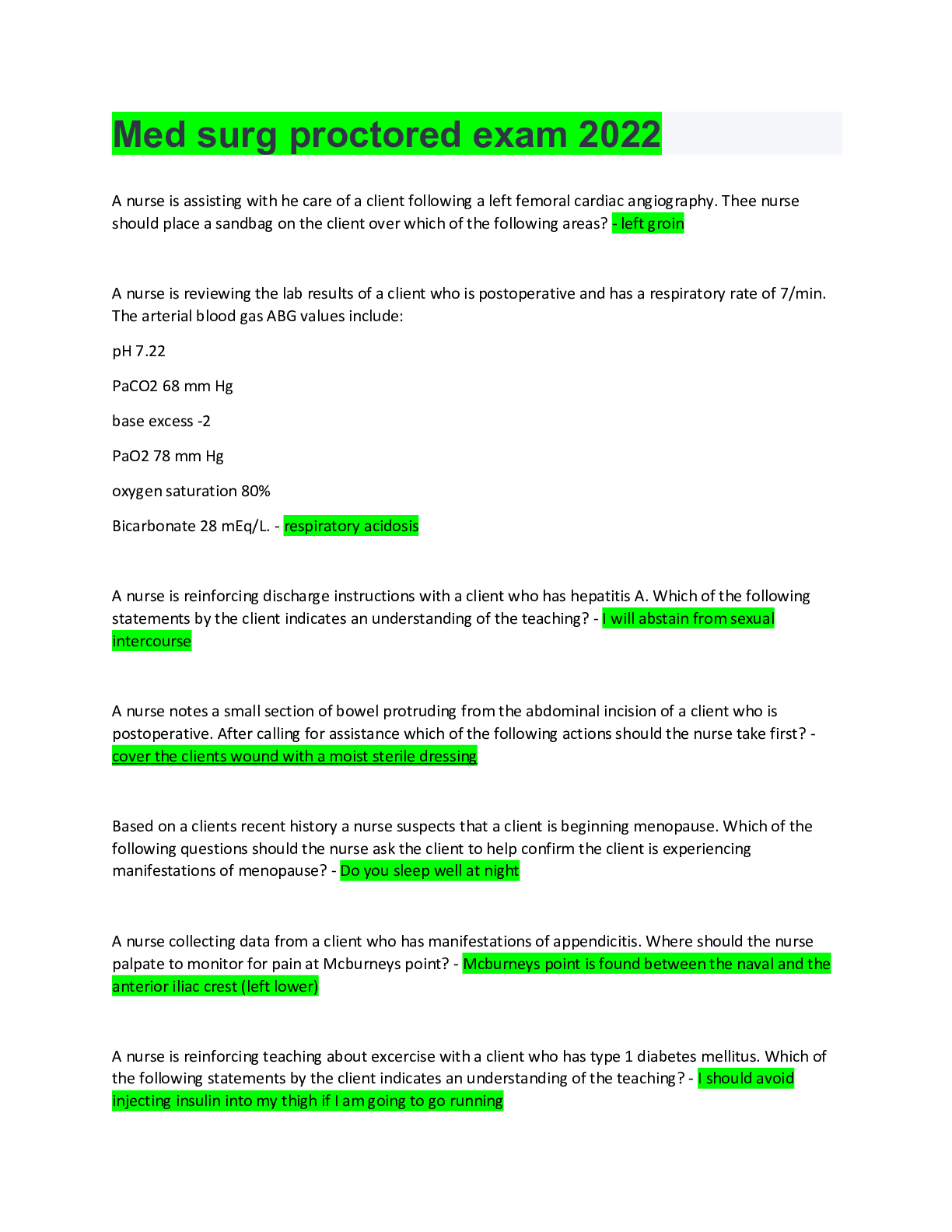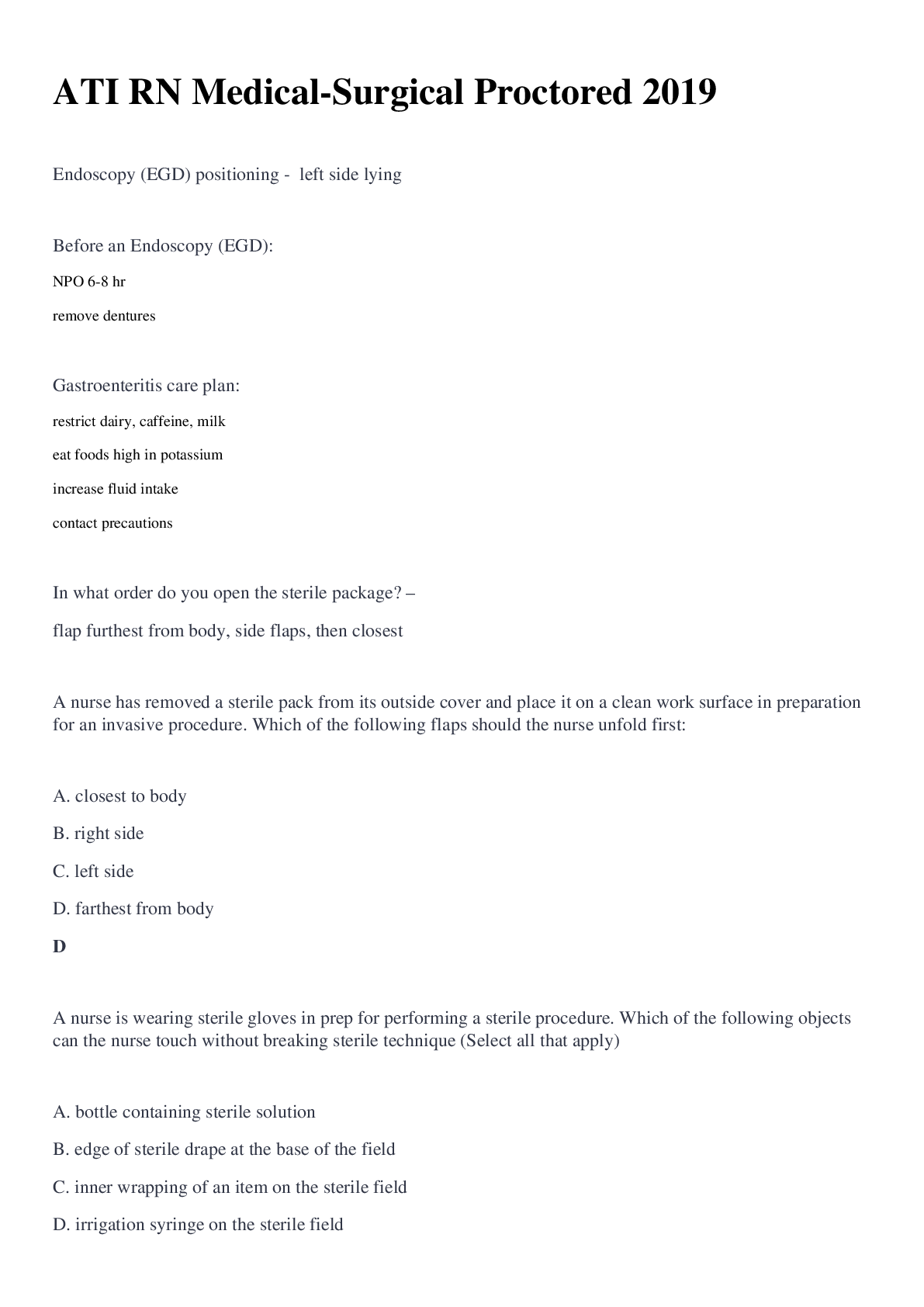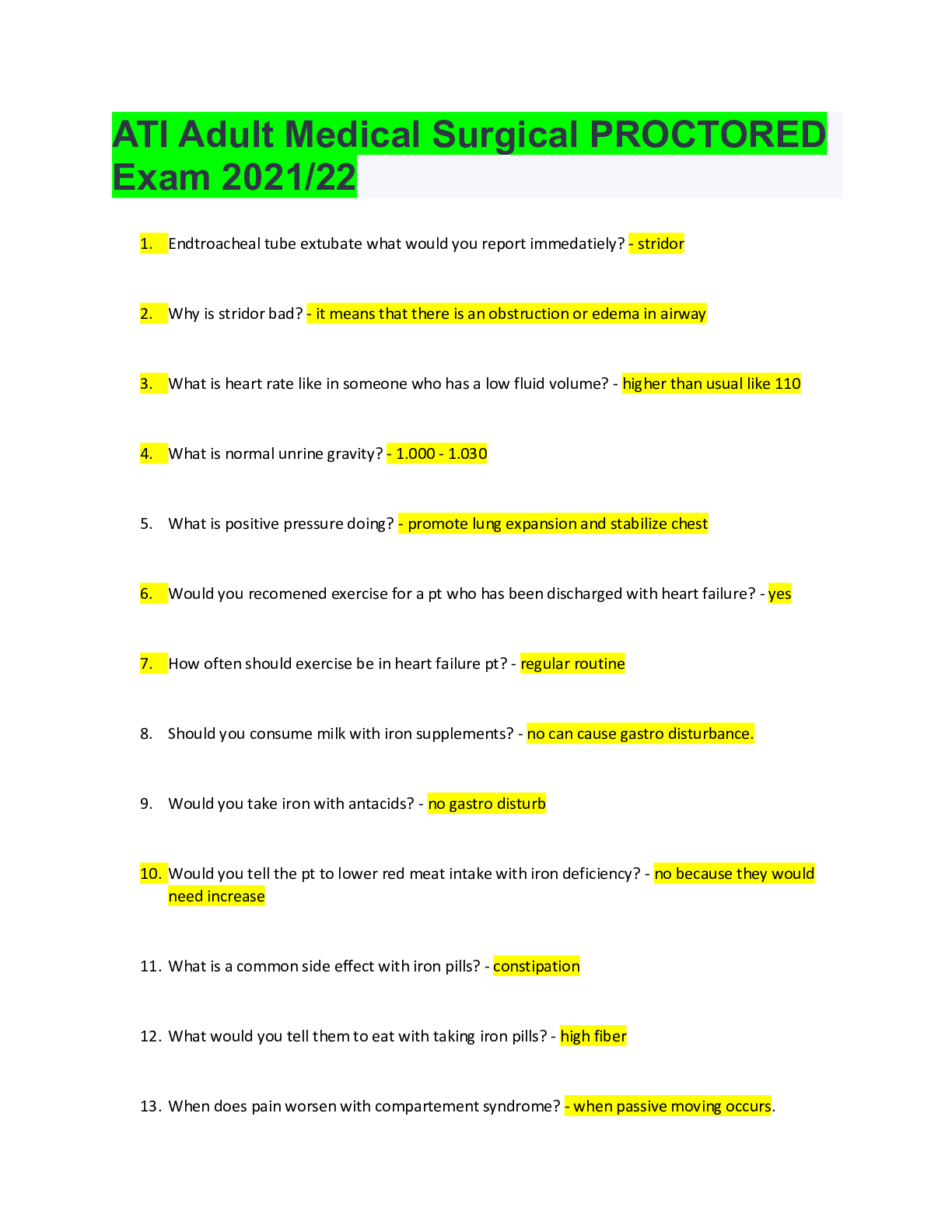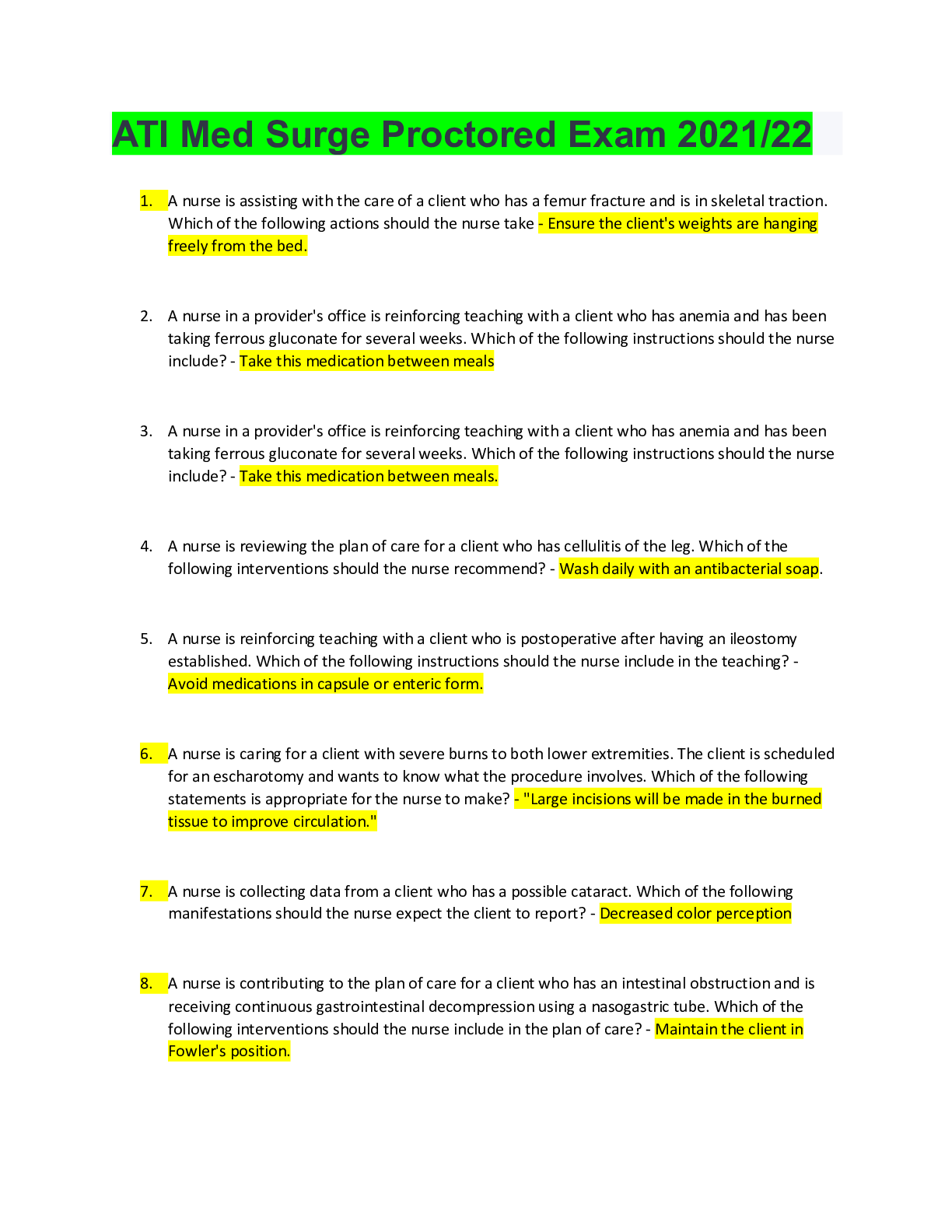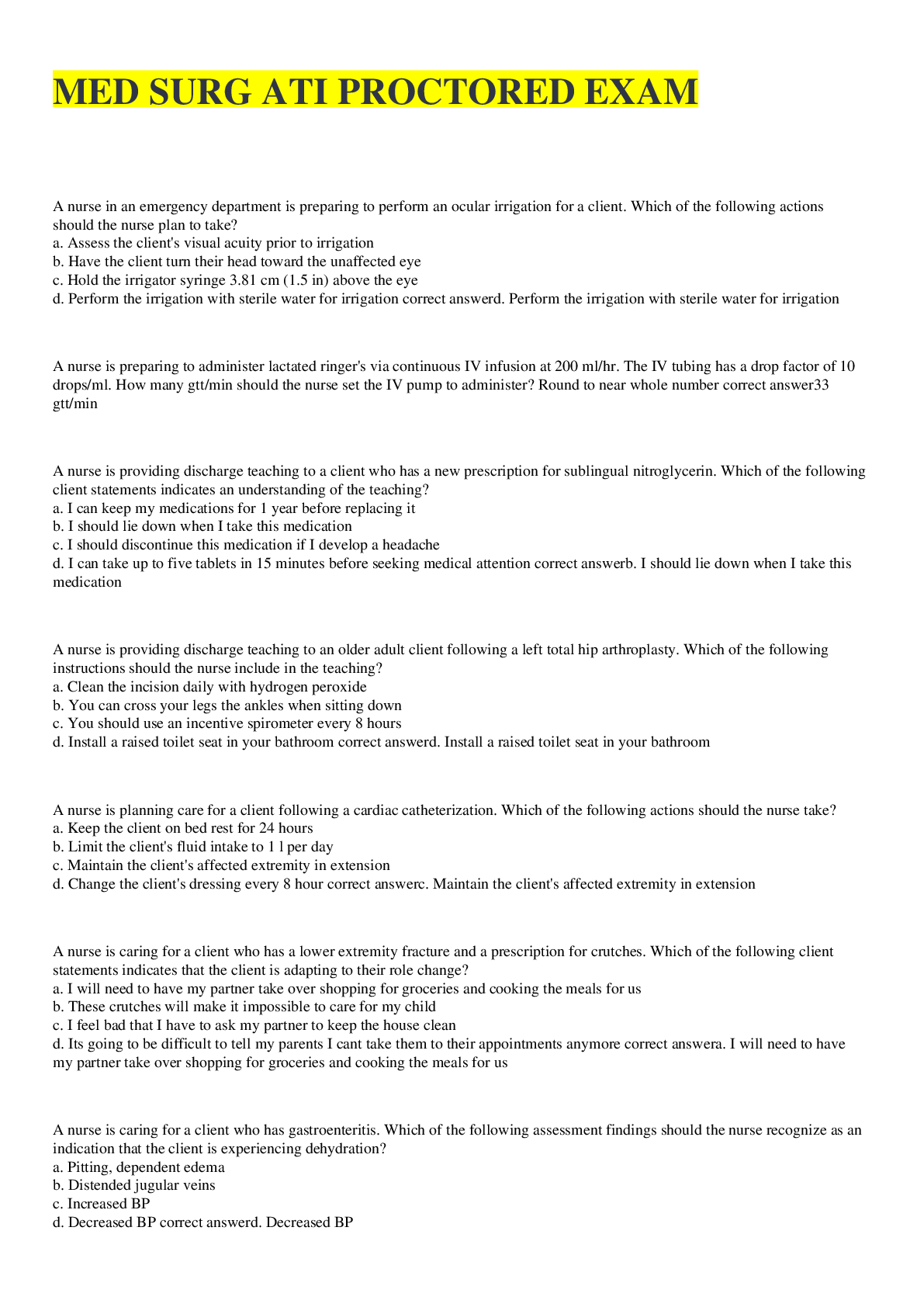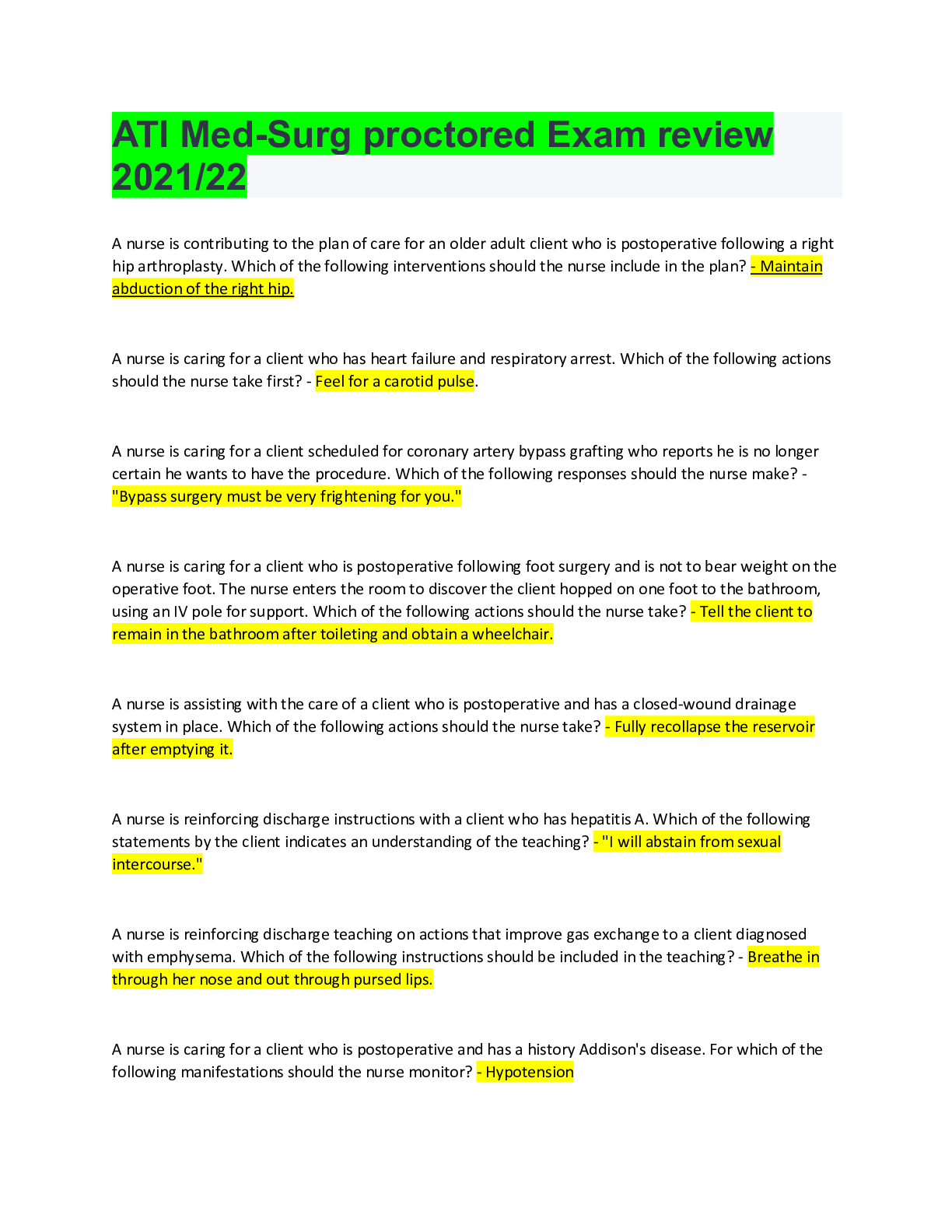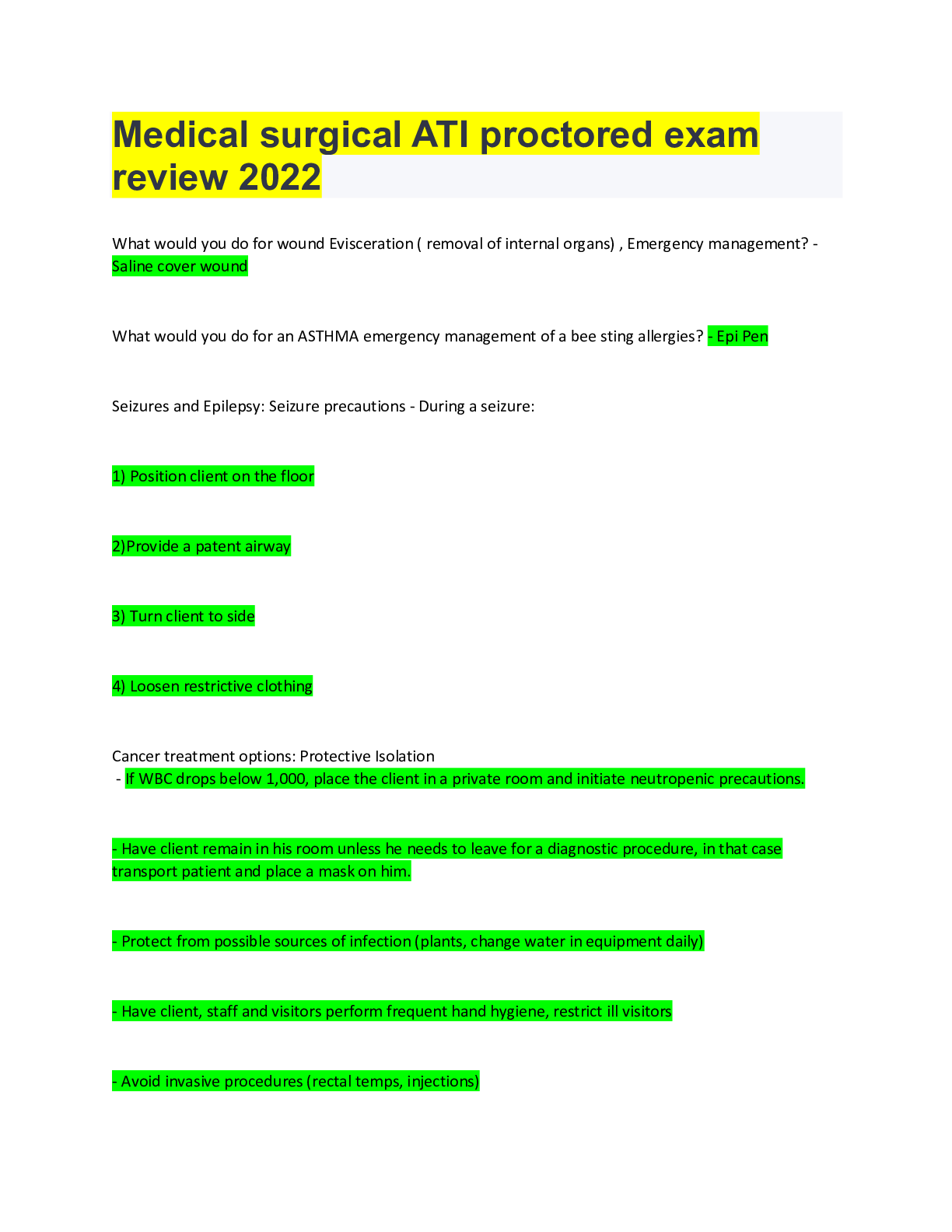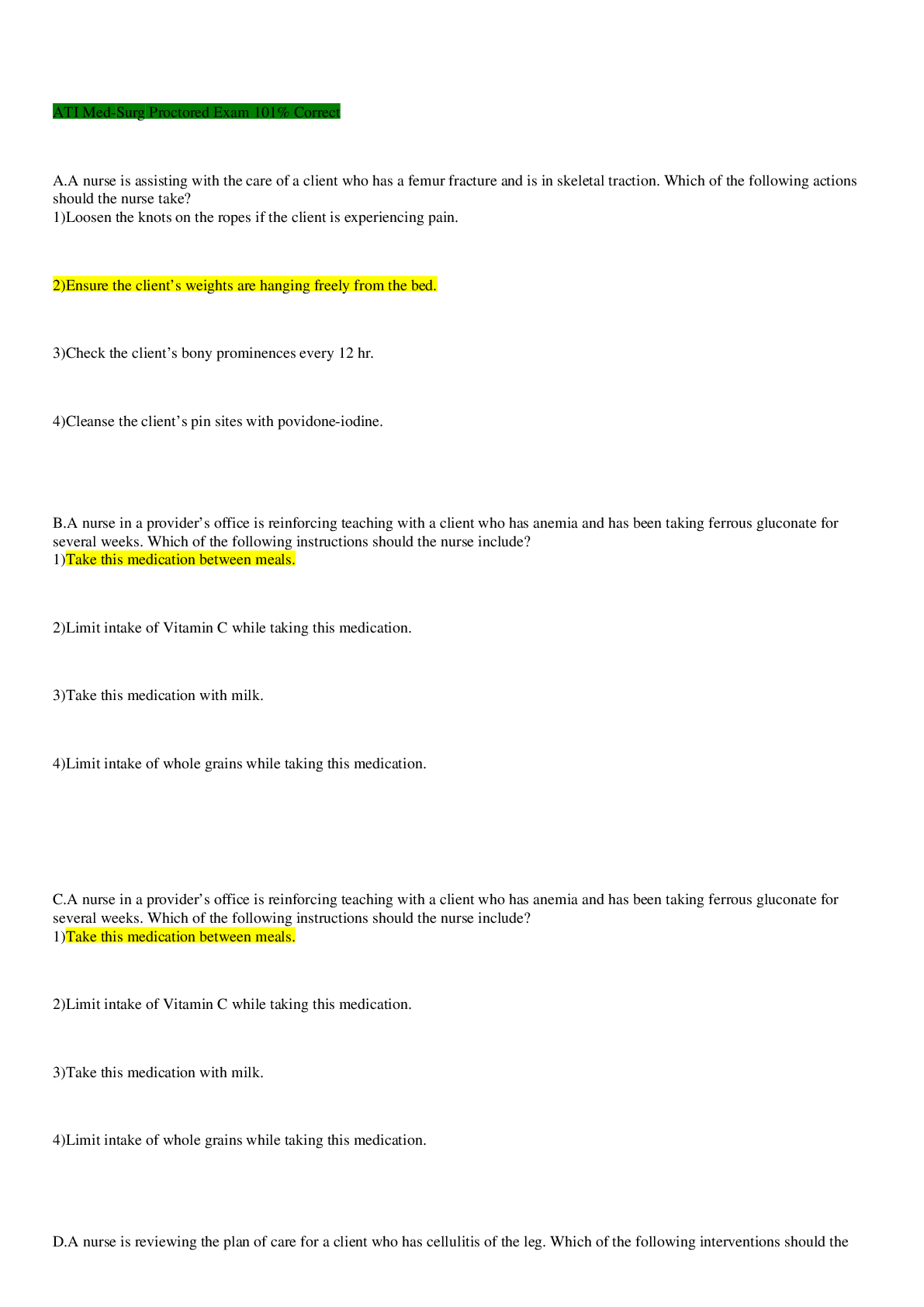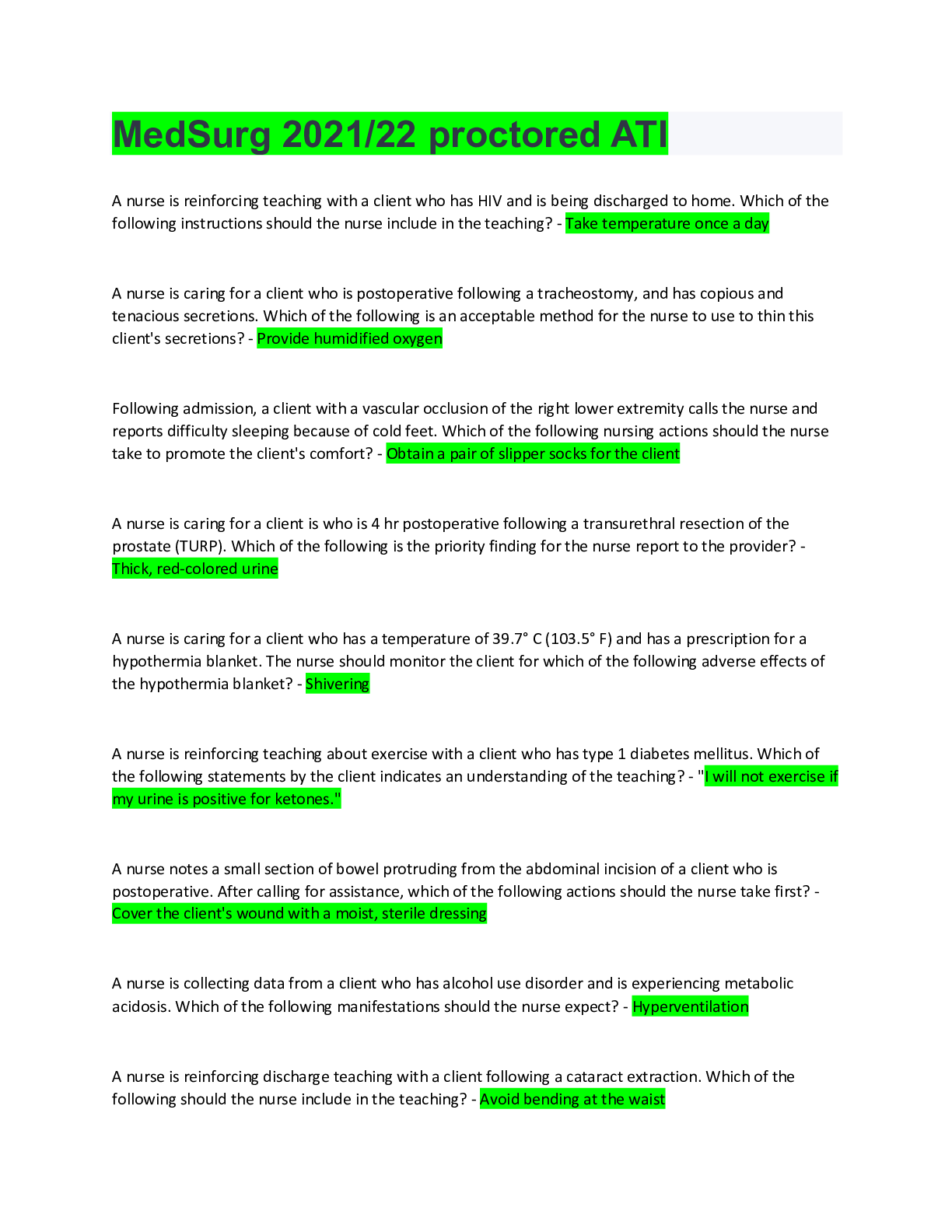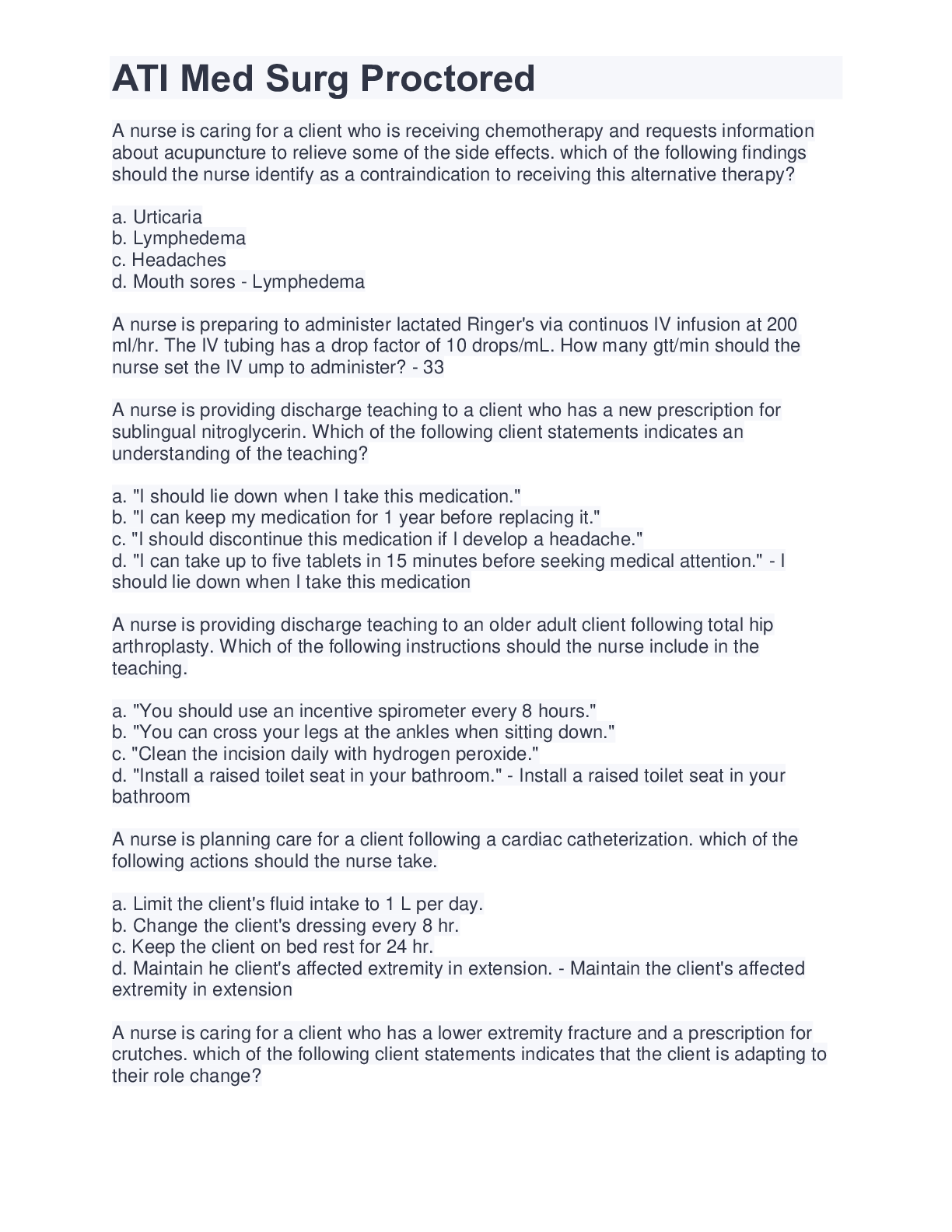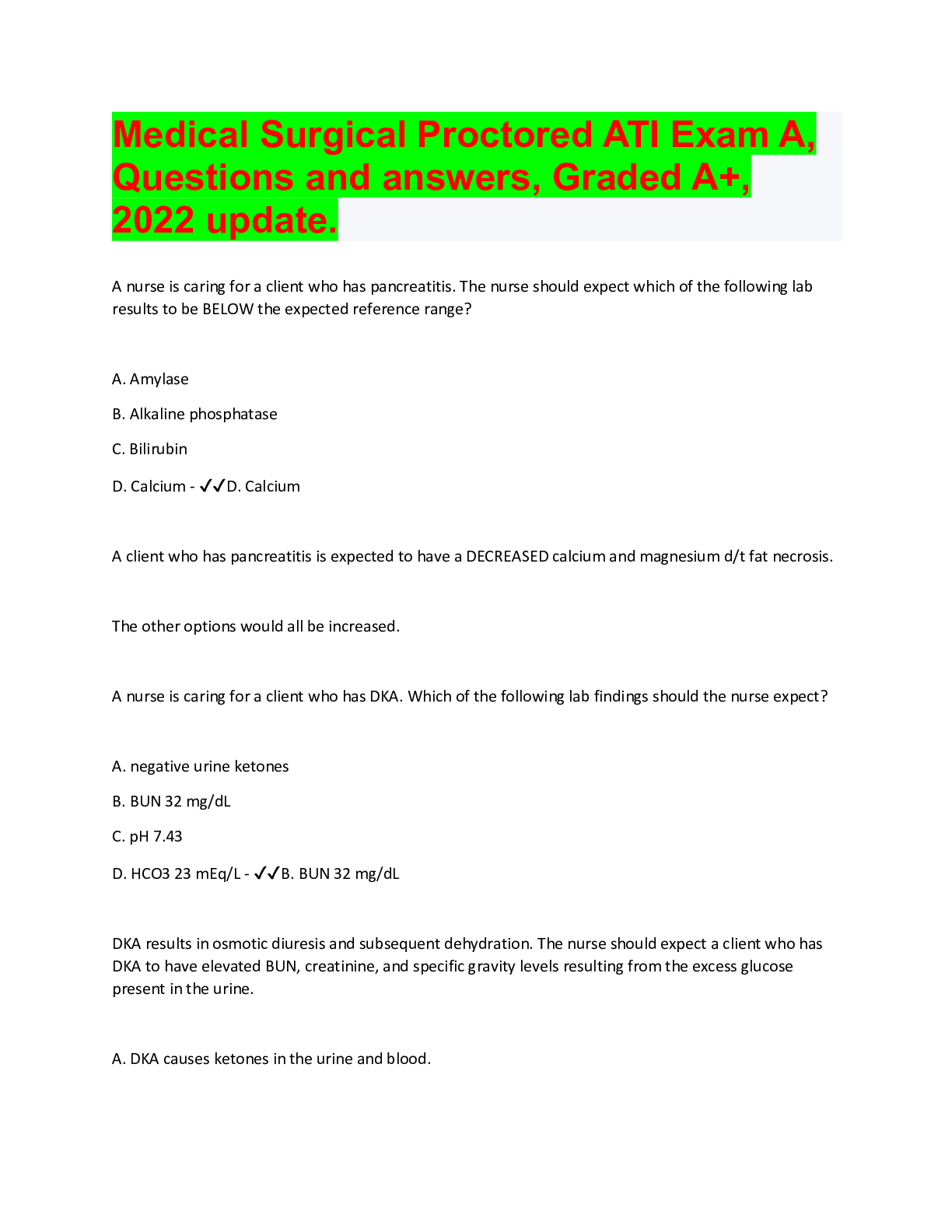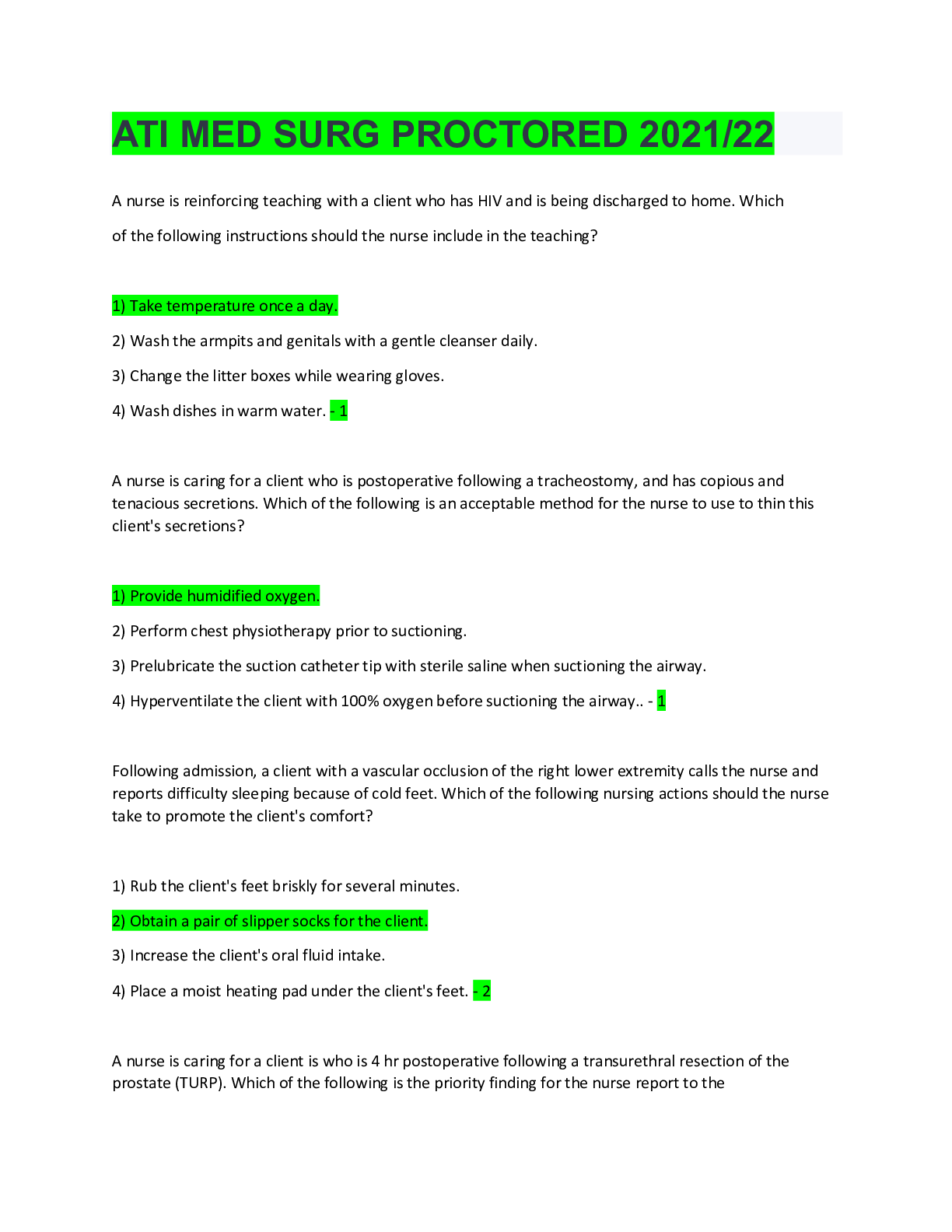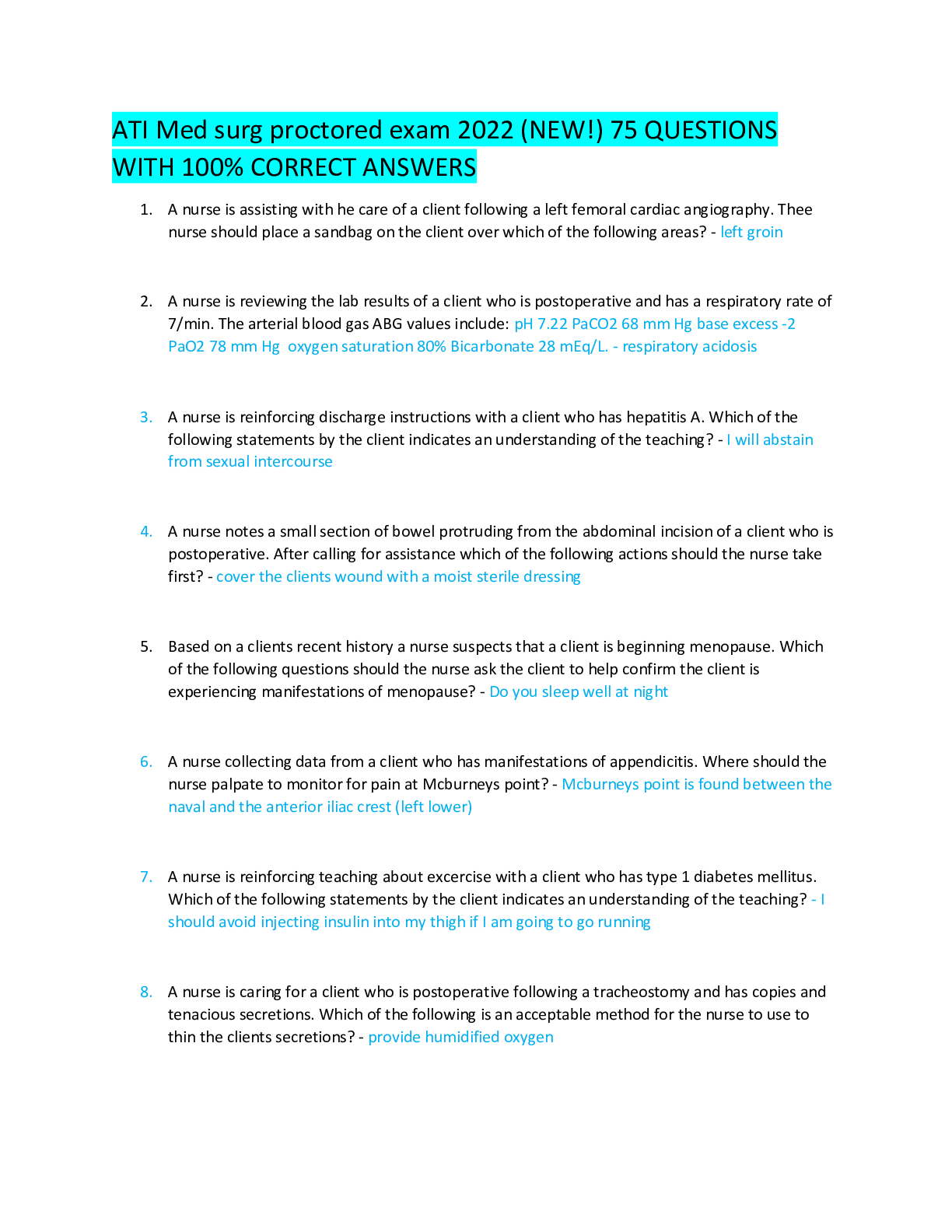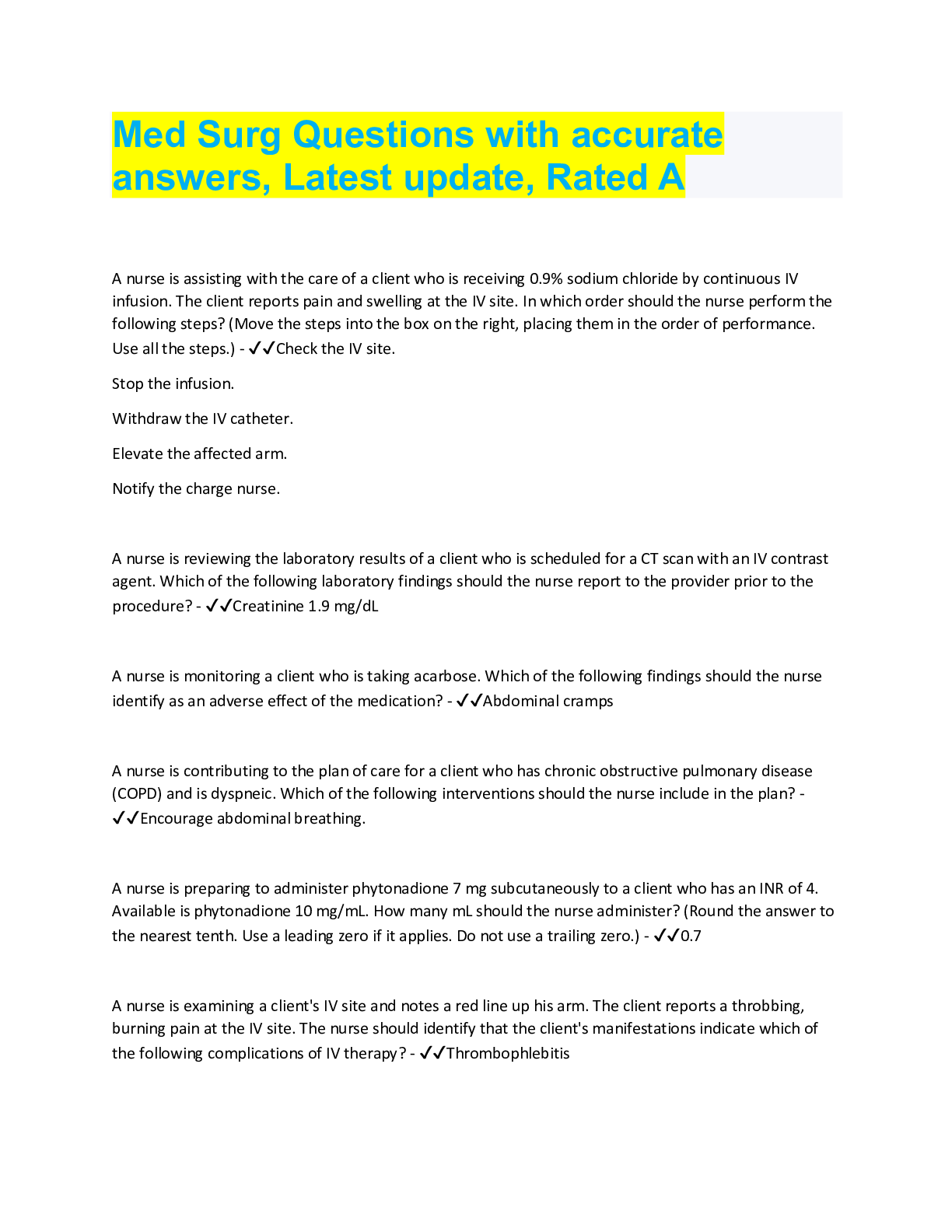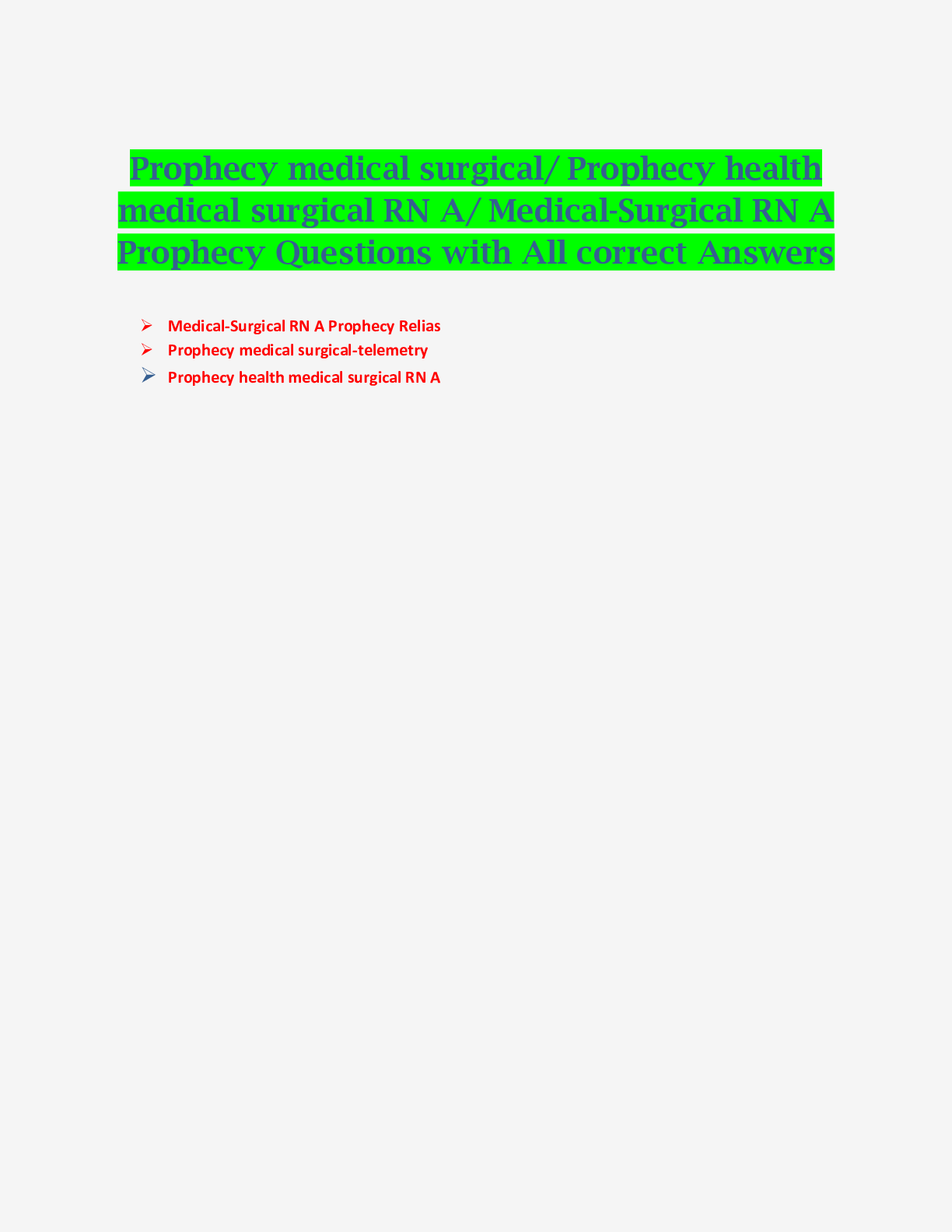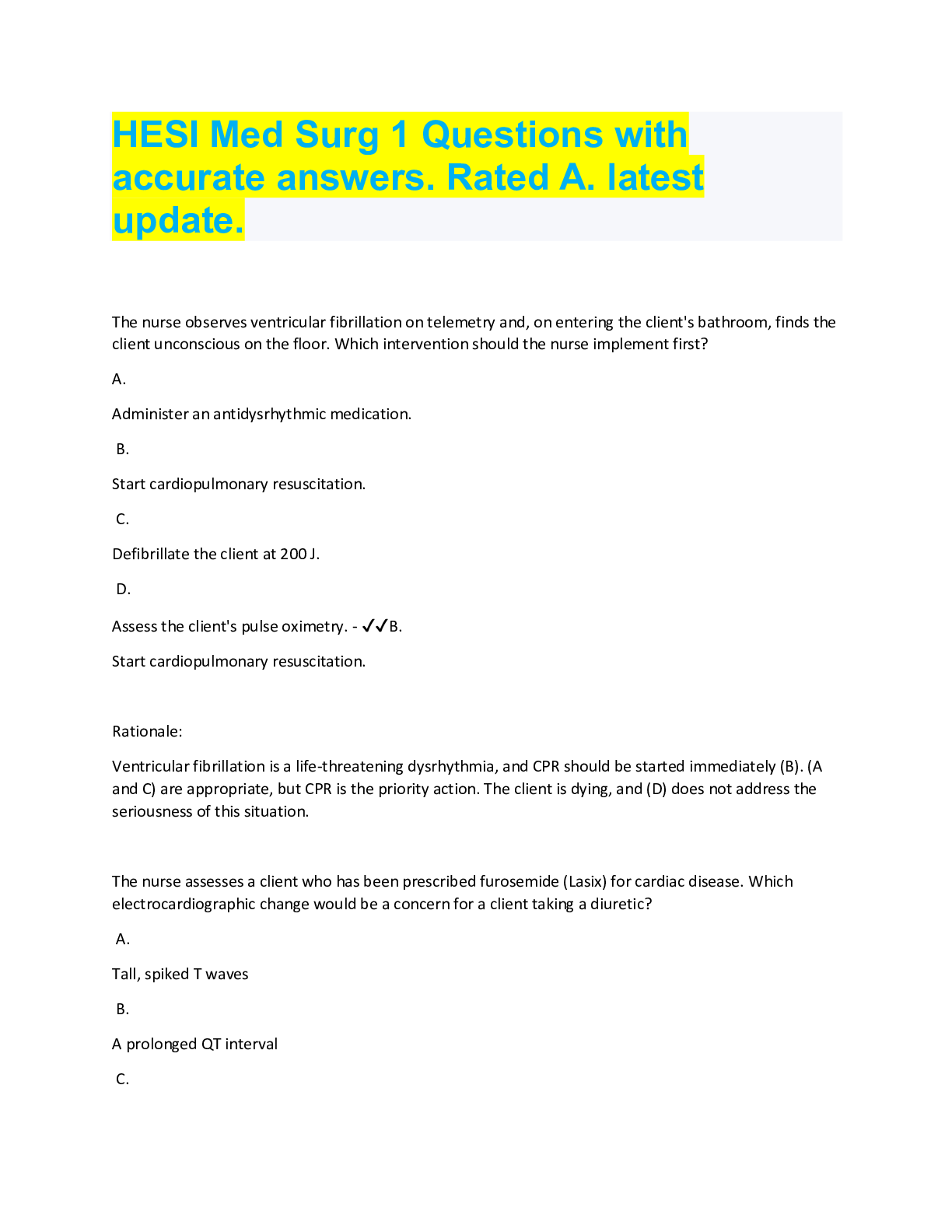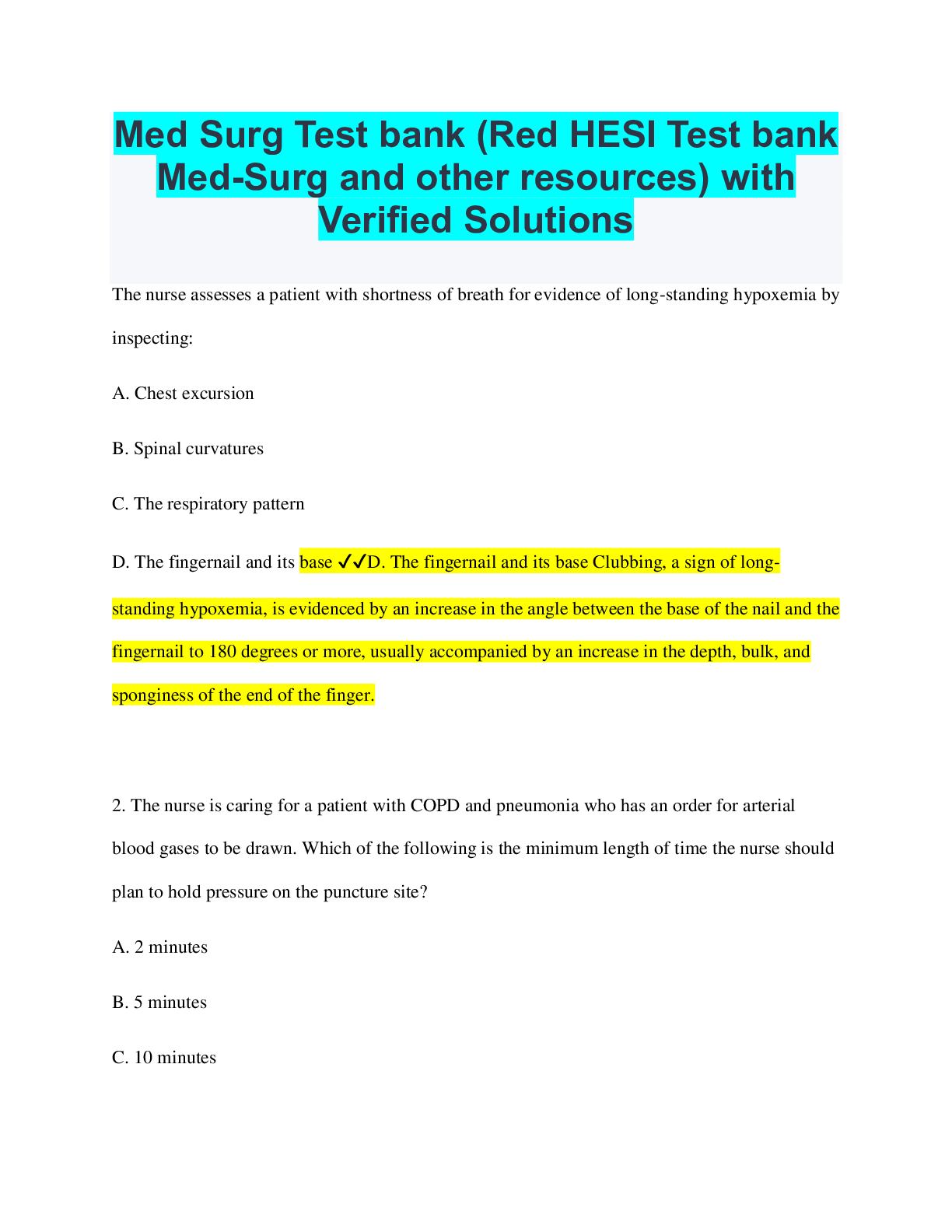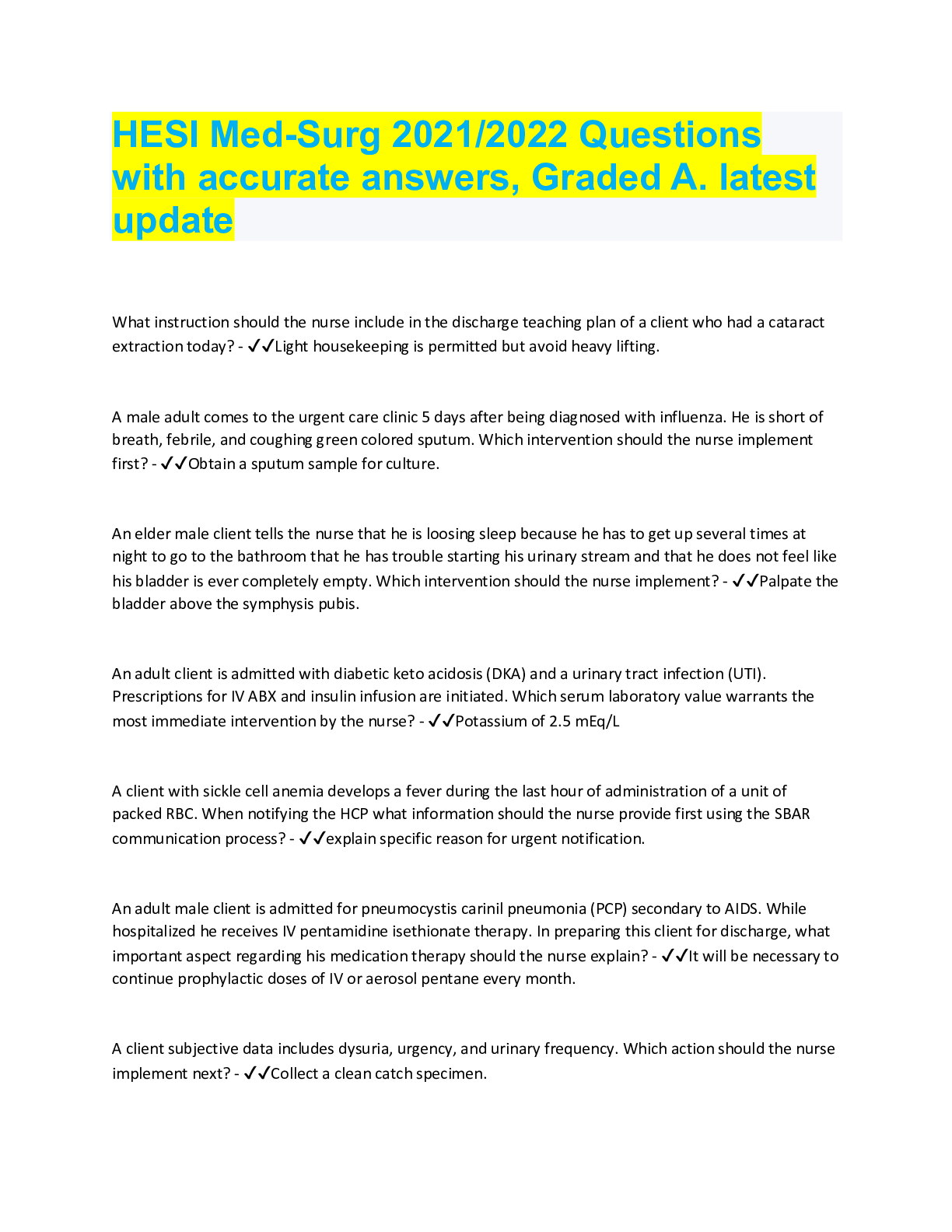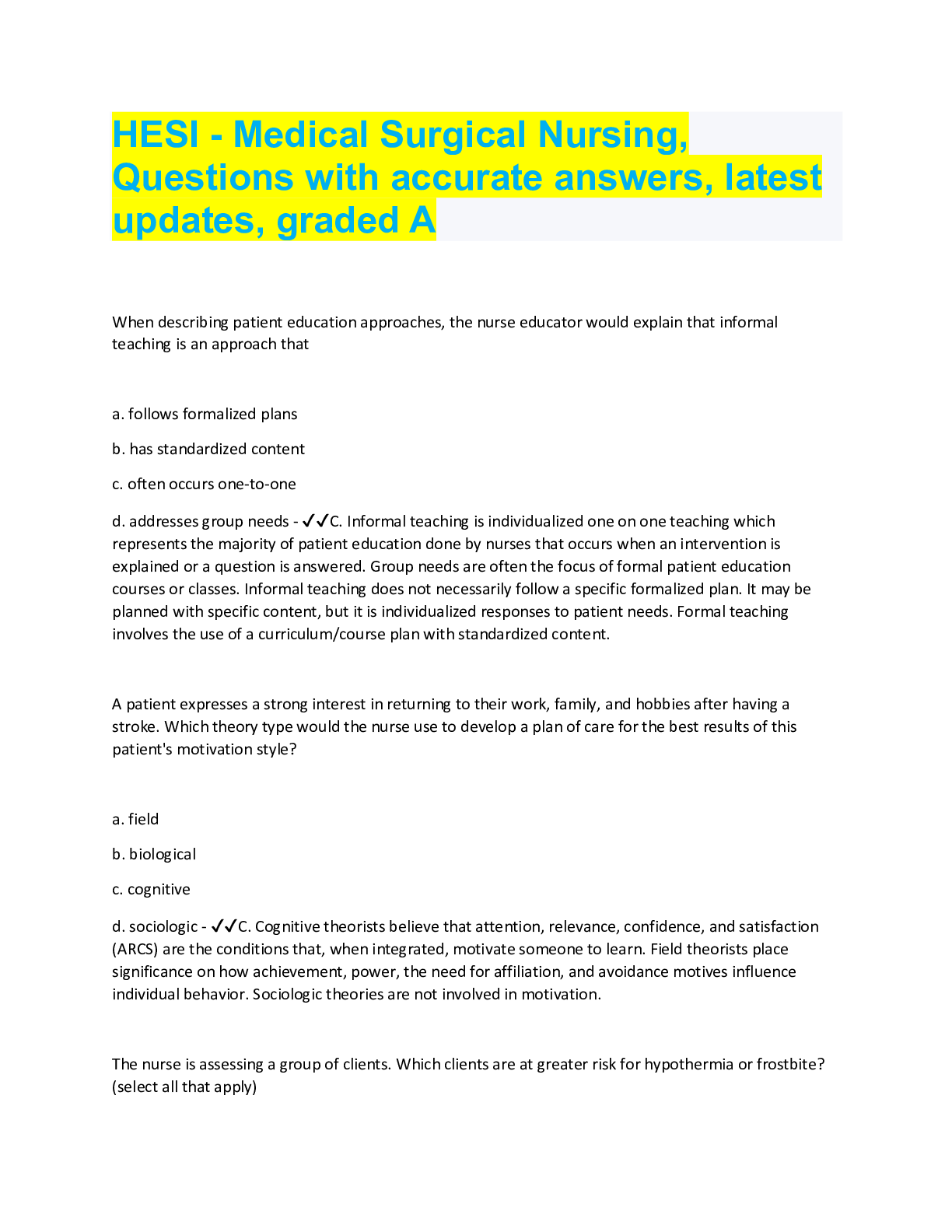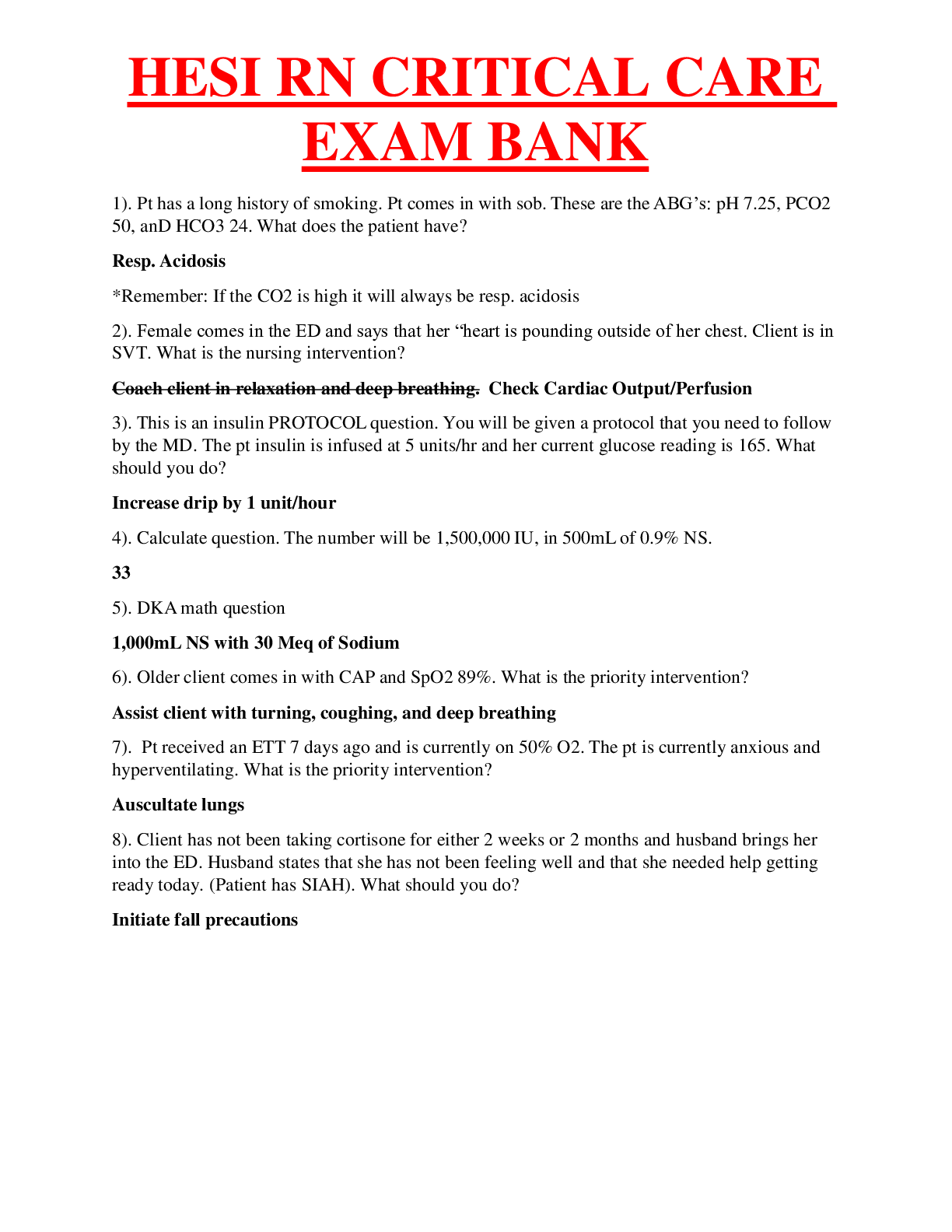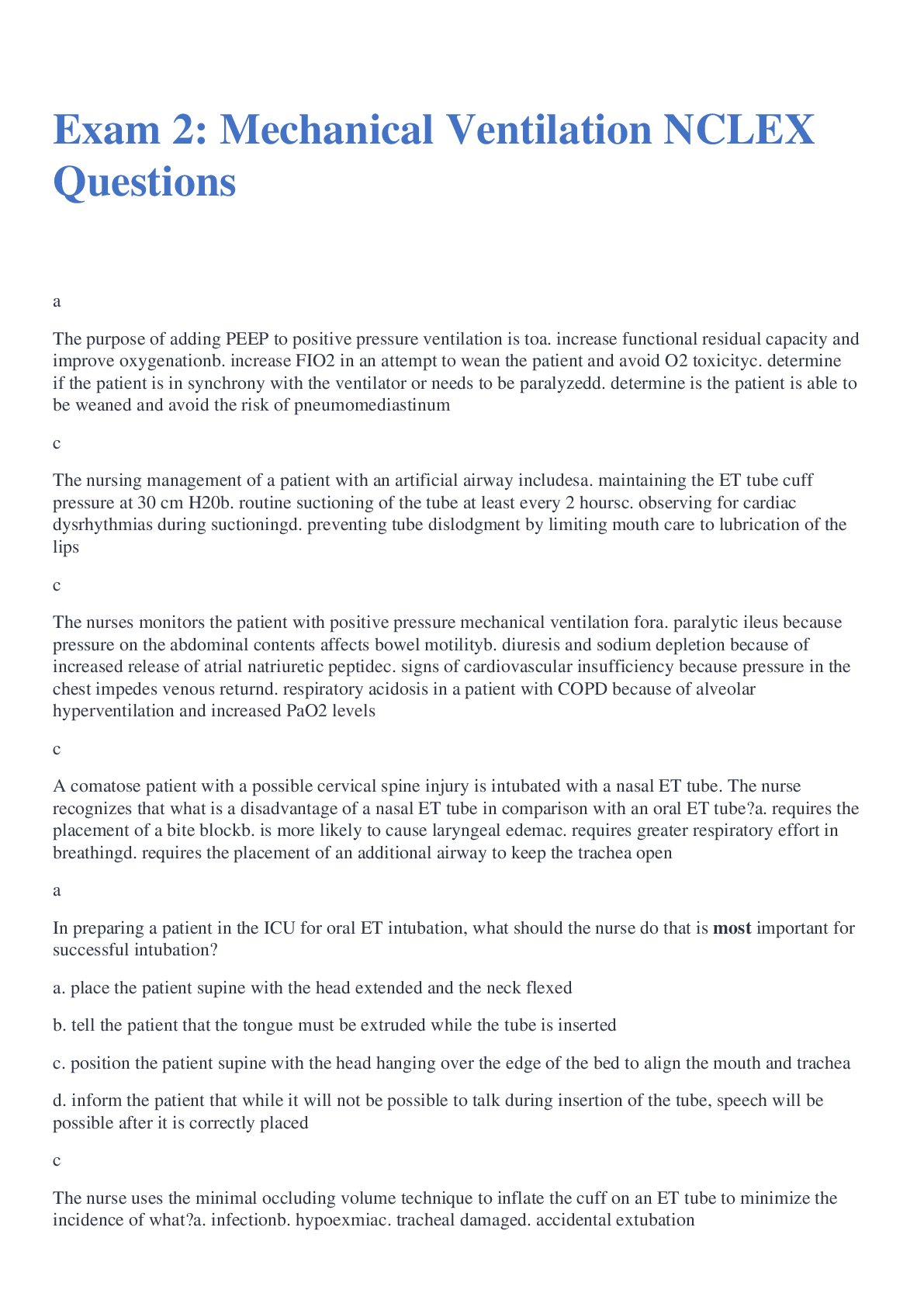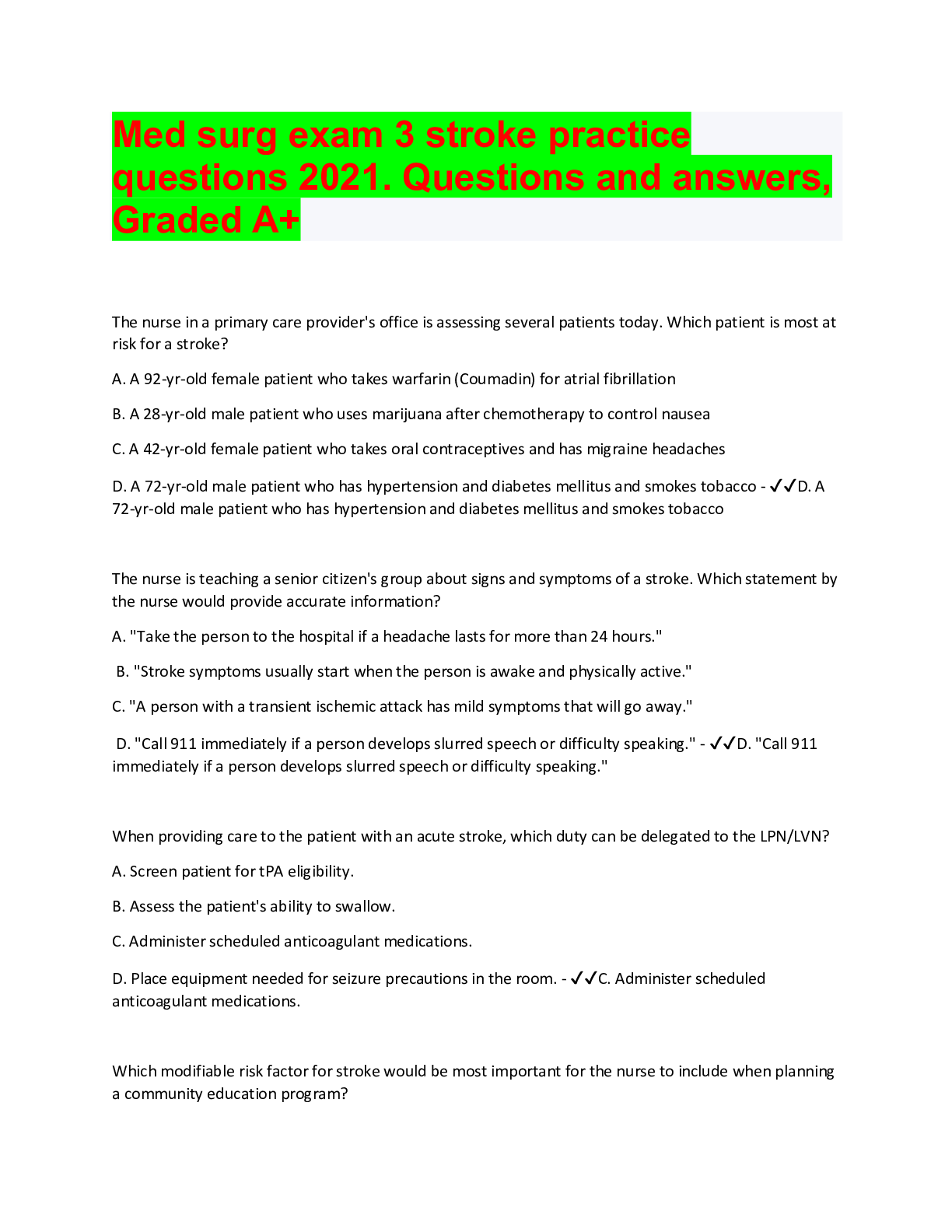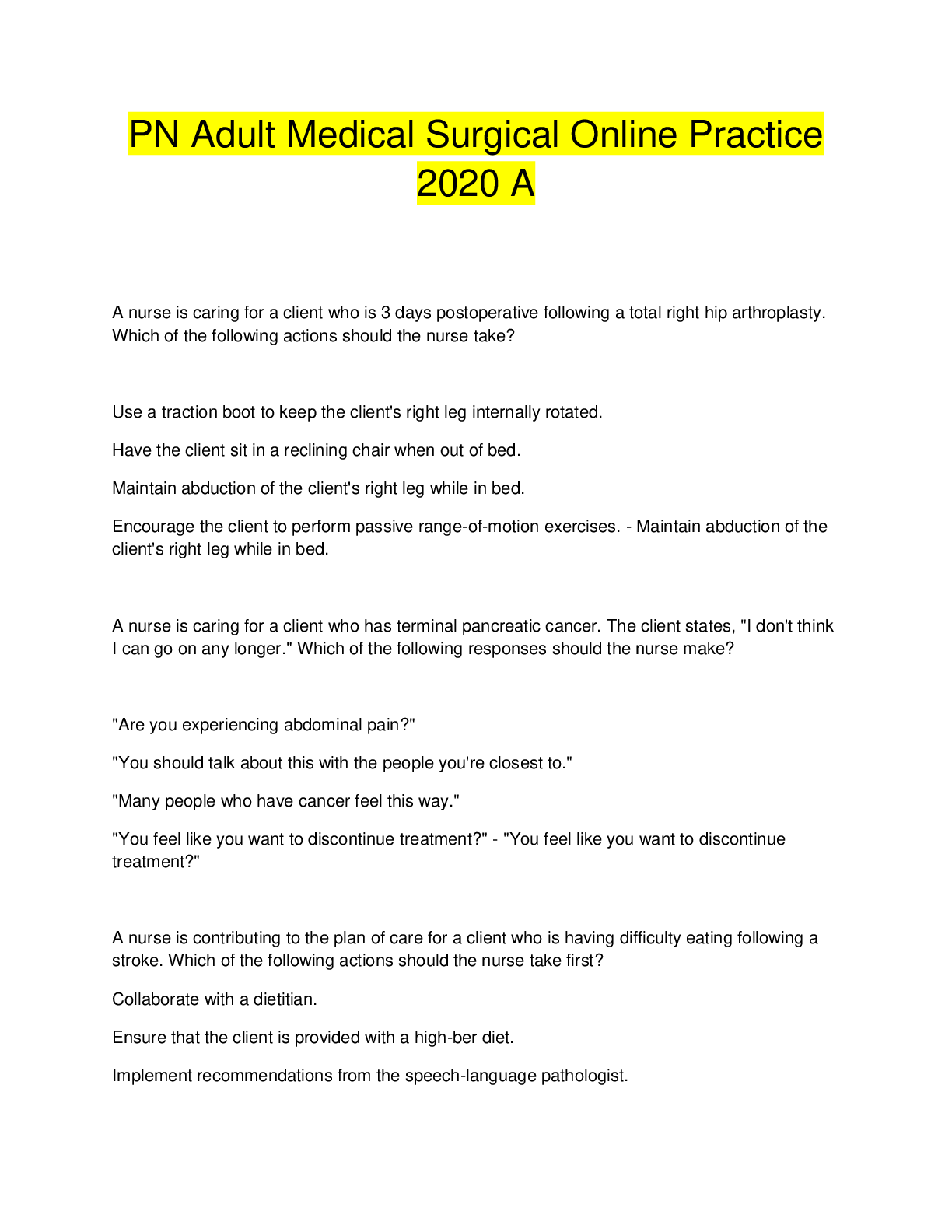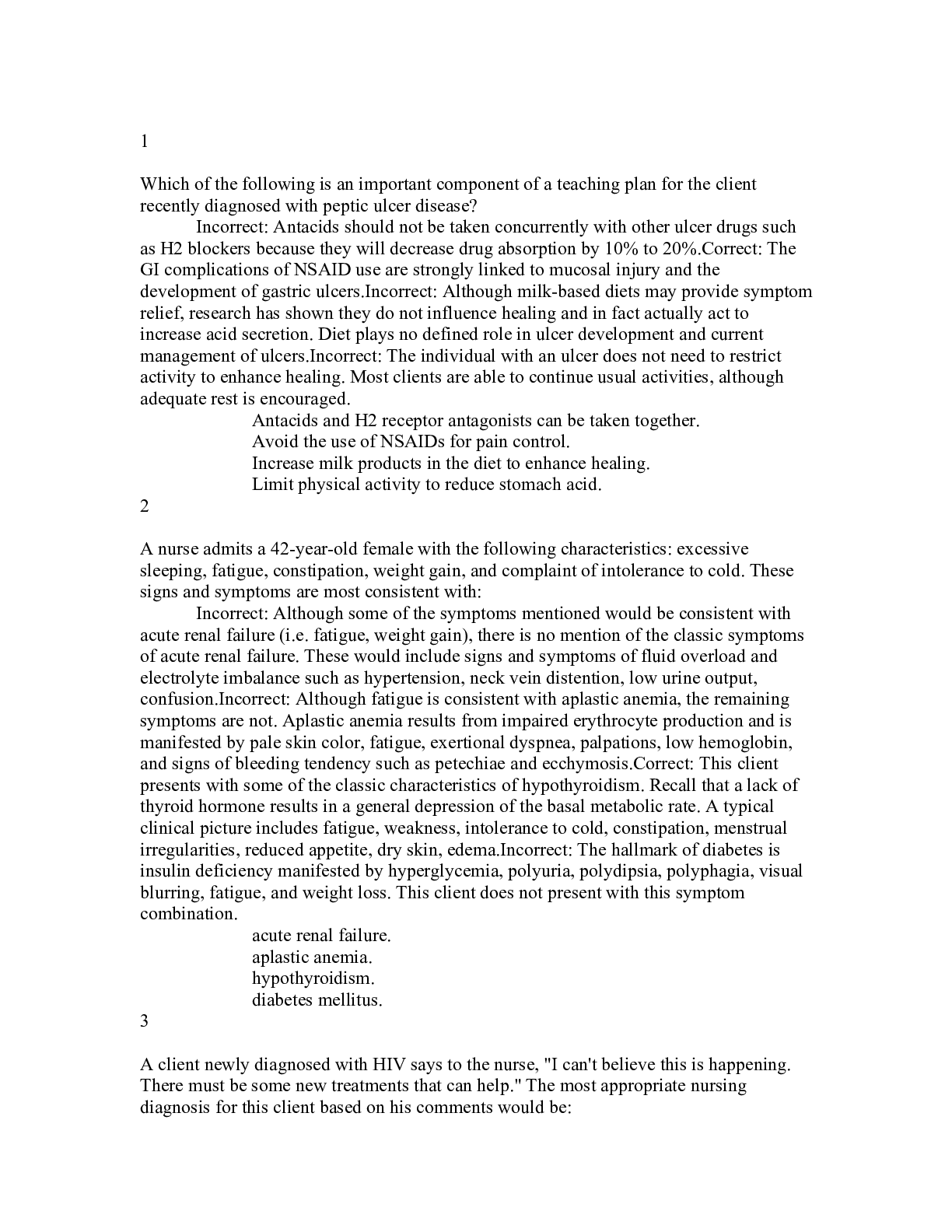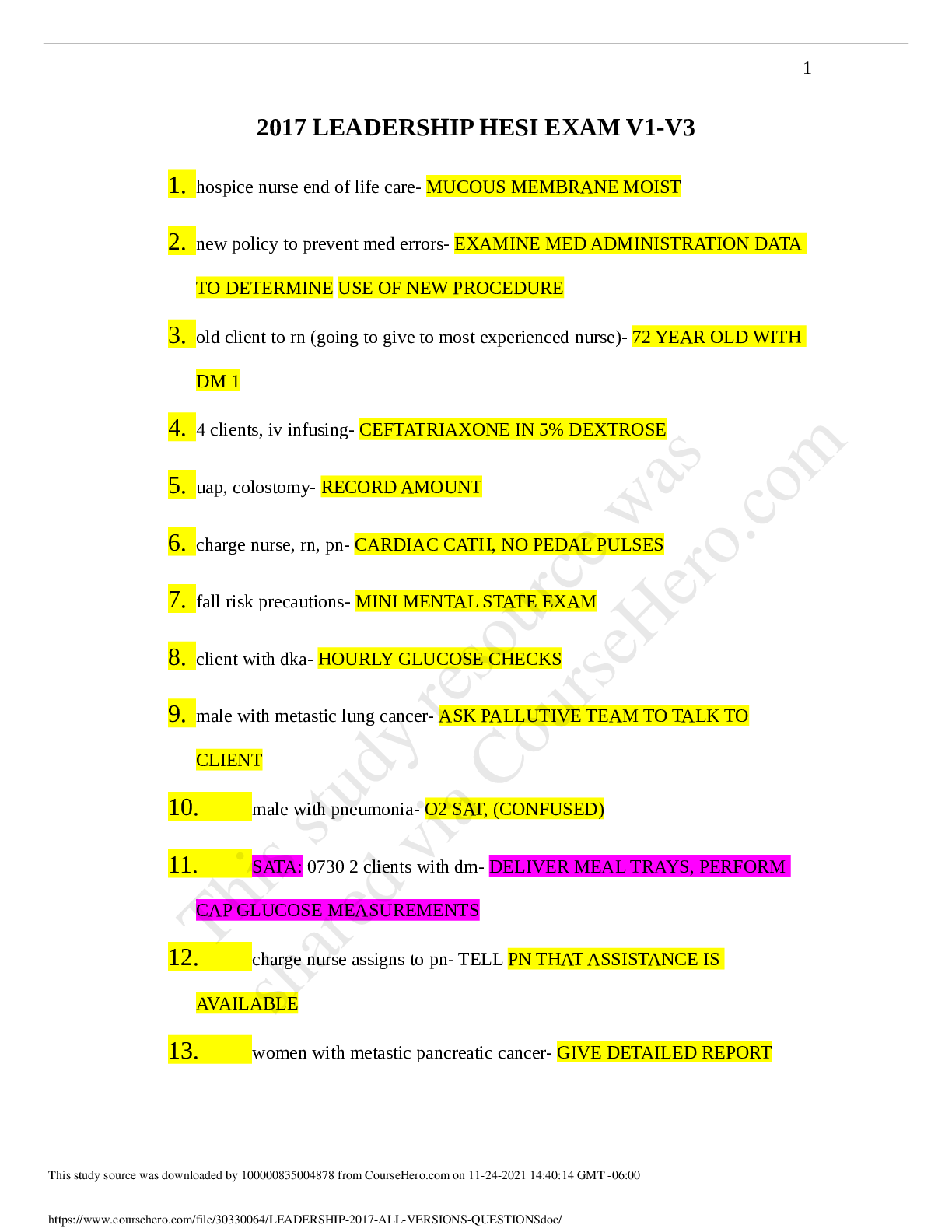*NURSING > MED-SURG EXAM > Med surg quiz 1 practice questions with accurate answers, Graded A+ (All)
Med surg quiz 1 practice questions with accurate answers, Graded A+
Document Content and Description Below
Med surg quiz 1 practice questions with accurate answers, Graded A+ 1. The nurse requests the client to sign a surgical informed consent form for an emergency appendectomy. Which statement by the... client indicates further teaching is needed? 1. "I will be glad when this is over so I can go home today." 2. "I will not be able to eat or drink anything prior to my surgery." 3. "I can practice relaxing by listening to my favorite music." 4. "I will need to get up and walk as soon as possible." - ✔✔1. "I will be glad when this is over so I can go home today." 2. The nurse in the holding area of the surgery department is interviewing a client who requests to keep his religious medal on during surgery. Which intervention should the nurse implement? 1. Notify the surgeon about the client's request to wear the medal 2. Tape the medal to the client and allow the client to wear the medal 3. Request the family member take the medal prior to surgery 4. Explain taking the medal to surgery is against the policy - ✔✔2. Tape the medal to the client and allow the client to wear the medal 3. The nurse must obtain surgical consent forms for the scheduled surgery. Which client would not be able to consent legally to surgery? 1. The 65 year old client who cannot read or write 2. The 30 year old who does not understand English 3. The 16 year old who has a fractured ankle 4. The 8- year old who is not oriented to the day - ✔✔3. The 16 year old who has a fractured ankle 4. The nurse is preparing a client for surgery. Which intervention should the nurse implement first? 1. Check the permit for the spouse's signature 2. Take and document intake and output 3. Administer the on-call sedative 4. Complete the preoperative checklist - ✔✔4. Complete the preoperative checklist 5. The nurse is interviewing a surgical client in the holding area. Which information should the nurse report to the anesthesiologist? Select all that apply 1. The client has loose, decayed teeth 2. The client is experiencing anxiety 3. The client smokes two packs of cigarettes a day 4. The client has had a chest x ray which does not show infiltrates 5. The client reports using herbs - ✔✔1. The client has loose, decayed teeth 3. The client smokes two packs of cigarettes a day 5. The client reports using herbs 6. Which task would be most appropriate for the nurse to delegate to the UAP (unlicensed assistive personnel)? 1. Complete the preop checklist 2. Assess the client's preop vital signs 3. Teach the client about coughing and deep breathing 4. Assist the client to remove clothing and jewelry - ✔✔4. Assist the client to remove clothing and jewelry 7. The nurse is assessing a client in the day surgery unit who states "I am really afraid of having this surgery. I'm afraid of what they will find." Which statement would be the best therapeutic response by the nurse? 1. "Don't worry about your surgery. It is safe." 2. "Tell me why you're worried about the surgery." 3. "Tell me about your fears of having this surgery." 4. "I understand how you feel, surgery is frightening." - ✔✔3. "Tell me about your fears of having this surgery." 8. The 68 year old client is scheduled for intestinal surgery does not have clear fecal contents after 3 tap water enemas. Which intervention should the nurse implement first? 1. Notify the surgeon of the client's status 2. Continue giving enemas until clear 3. Increase the client's fluid IV rate 4. Obtain STAT serum electrolytes - ✔✔1. Notify the surgeon of the client's status 9. The nurse is caring for a male client scheduled for abdominal surgery. Which interventions should the nurse include in the plan of care? Select all that apply 1. Perform passive ROM exercises 2. Discuss how to cough and deep breathe effectively 3. Tell the client he can have a meal in the PACU 4. Teach ways to manage post op pain 5. Discuss events which occur in the post-anesthesia care unit - ✔✔2. Discuss how to cough and deep breathe effectively 4. Teach ways to manage post op pain 5. Discuss events which occur in the post-anesthesia care unit 10. The nurse is caring for a client scheduled for total hip replacement. Which behavior indicates the need for further preoperative teaching? 1. The client uses the diaphragm and abdominal muscles to inhale through the nose and exhale through the mouth 2. The client demonstrates dorsiflexion of the feet, flexing of the toes, and moves the feet in a circular motion 3. The client uses the incentive spirometer and inhales slowly and deeply so the piston rises to the preset volume 4. The client gets out of bed by lifting straight upright from the waist and then swings both legs along the side of the bed - ✔✔4. The client gets out of bed by lifting straight upright from the waist and then swings both legs along the side of the bed 11. The nurse is completing preoperative assessment on a male client who states, "I am allergic to codeine." Which intervention should the nurse implement first? 1. Apply an allergy bracelet on the client's wrist 2. Label the client's allergies on the front of the chair 3. Ask the client what happens when he takes codeine 4. Document the allergy on the medication administration record - ✔✔3. Ask the client what happens when he takes codeine 12. Which lab result would require immediate intervention by the nurse for the client scheduled for surgery? 1. Calcium 9.2 2. Bleeding time 2 minutes 3. Hemoglobin 15 4. Potassium 2.4 - ✔✔4. Potassium 2.4 13. Which activities are the circulating nurse's responsibilities in the OR? 1. Monitor the position of the client, prepare the surgical site, and ensure the client's safety 2. Give preop meds in the holding area and monitor the client's response to anesthesia 3. Prepare sutures; set up the sterile fild, and count all needles and sponges and instruments 4. Prepare the meds to be administered by the anesthesiologist and change the tubing for the anesthesia machine - ✔✔1. Monitor the position of the client, prepare the surgical site, and ensure the client's safety 14. The circulating nurse observes the surgical scrub technician remove a sponge from the edge of the sterile field with a clamp and place the sponge and clamp in a designated area. Which action should the nurse implement? 1. Place the sponge back where it was 2. Tell the technician to not waste supplies 3. Do nothing because this is the correct procedure 4. Take the sponge out of the room immediately - ✔✔3. Do nothing because this is the correct procedure 16. Which violation of surgical asepsis would require immediate intervention by the circulating nurse? 1. Surgical supplies were cleaned and sterilized prior to the case 2. The circulating nurse is wearing a long-sleeved sterile gown 3. Masks covering the mouth and nose are being worn by the surgical team 4. The scrub nurse setting up the sterile field is wearing artificial nails - ✔✔4. The scrub nurse setting up the sterile field is wearing artificial nails 17. The nurse identifies the nursing diagnosis "risk for injury related to positioning" for the client in the operating room. Which nursing intervention should the nurse implement? 1. Avoid using the cautery unit, which does not have a biomedical tag on it 2. Carefully pad the client's elbows before covering the client with a blanket 3. Apply a warming pad on the OR table before placing the client on the table 4. Check the chart for any prescription or OTC medication use - ✔✔2. Carefully pad the client's elbows before covering the client with a blanket 18. The circulating nurse is positioning clients for surgery. Which client has the greatest potential for nerve damage? 1. The 16 year old in dorsal recumbent position having an appendectomy 2. The 68 year old in the Trendlenburg position having a cholecystectomy 3. The 45 year old in the reverse trendlenburg position having a biopsy 4. The 22 year old client in the lateral postion having a nephrectomy - ✔✔2. The 68 year old in the Trendlenburg position having a cholecystectomy 19. Which situation demonstrates the circulating nurse acting as the client's advocate? 1. Plays the client's favorite audio book during surgery 2. Keeps the family informed of the findings of the surgery 3. Keeps the operating room door closed at all times 4. Calls the client by the first name when the client is recovering - ✔✔3. Keeps the operating room door closed at all times 20. The circulating nurse is planning the care for an intraoperative client. Which statement is the expected outcome? 1. The client has no injuries from the OR equipment 2. The client ahs no post op infection 3. The client has stable vital signs during surgery 4. The client recovers from anesthesia - ✔✔1. The client has no injuries from the OR equipment 21. Which nursing intervention has the highest priority when preparing the client for a surgical procedure? 1. Pad the client's elbows and knees 2. Apply soft restraint straps to the extremities 3. Prepare the client's incision site 4. Document the temperature of the room - ✔✔2. Apply soft restraint straps to the extremities 22. The nursing manager is making assignments for the OR. Which case should the manager assign to the inexperienced nurse? 1. The client having open-heart surgery 2. The client having a biopsy of the breast 3. The client having laser eye surgery 4. The client having a laparoscopic knee repair - ✔✔2. The client having a biopsy of the breast 23. The circulating nurse assesses tachycardia and hypotension in the client. Which interventions should the nurse implement? 1. Prepare ice packs and mix dantrolene sodium 2. Request the defibrillator be brought into the OR 3. Draw a PTT and prepare a heparin drip 4. Obtain finger stick blood glucose immediately - ✔✔1. Prepare ice packs and mix dantrolene sodium 24. The nurse is planning care of the surgical client having conscious sedation. Which intervention has highest priority? 1. Assess the client's respiratory status 2. Monitor the client's urinary output 3. Take a 12-lead ECG prior to injection 4. Attempt to keep the client focused - ✔✔1. Assess the client's respiratory status 25. The PACU nurse is receiving the client from the OR. Which intervention should the nurse implement first? 1. Assess the client's breath sounds 2. Apply oxygen via nasal cannula 3. Take the client's BP 4. Monitor the pulse ox reading - ✔✔1. Assess the client's breath sounds 26. Which assessment data indicate the post op client who had spinal anesthesia is suffering a complication of the anesthesia? 1. Loss of sensation at the lumbar (L5) dermatome 2. Absence of the client's posterior tibial pulse 3. The client has a respiratory rate of 8 4. The BP is within 20% of the client's baseline - ✔✔3. The client has a respiratory rate of 8 27. The surgical clients V/S are T 98 degrees, P 106, R 24, BP 88/40. The client is awake and oriented times 3 and the skin is pale and damp. Which intervention should the nurse implement first? 1. Call the surgeon and report the V/S 2. Start an IV D5RL with 20 mEQ KCL at 125 ml/hr 3. Elevate the feet and lower the head of the bed 4. Monitor the vital signs every 15 minutes - ✔✔3. Elevate the feet and lower the head of the bed 28. The PACU nurse administers Narcan, an opioid antagonist, to a post op client. Which client problem should the nurse include to the plan of care based on this medication? 1. Alteration in comfort 2. Risk for depressed respiratory pattern 3. Potential for infection 4. Fluid and electrolyte imbalance - ✔✔2. Risk for depressed respiratory pattern 29. The 26 year old male client in the PACU has a HR of 110 and a rising temperature, and complains of muscle stiffness. Which interventions should the nurse implement? Select all 1. Give a backrub to the client to relieve stiffness 2. Apply ice packs to the axillary and groin areas 3. Prepare an ice slush for the client to drink 4. Prepare to administer dantrolene, a smooth-muscle relaxant 5. Reposition the client on a warming blanket - ✔✔2. Apply ice packs to the axillary and groin areas 30. Which data indicate to the nurse the client who is one day post op right total hip replacement is progressing as expected? 1. Urine output was 160 ml in the past 8 hours 2. Paralysis and parasthesia of the Right leg 3. T 99, P 98, R 20, and BP 100/60 4. Lungs are clear bilaterally in all lobes - ✔✔4. Lungs are clear bilaterally in all lobes 31. The nurse and the UAP are working on a surgical unit. Which task can the nurse delegate to the UAP? 1. Take routine V/S on clients 2. Check the Jackson Pratt insertion site 3. Hang the client's next IV bag 4. Ensure the client obtains pain relief - ✔✔1. Take routine V/S on clients 32. The charge nurse is making shift assignments. Which post op client should be assigned to the most experienced nurse? 1. The 4 year old who had a tonsillectomy and is able to swallow fluids 2. The 74 year old with a repair of the left hip who is unable to ambulate 3. The 24 year old who had an uncomplicated appendectomy the previous day 4. The 80 year old client with small bowel obstruction and CHF - ✔✔4. The 80 year old client with small bowel obstruction and CHF 33. Which statement would be an expected outcome for the post op client who had general anesthesia? 1. The client will be able to sit in the chair for 30 minutes 2. The client will have a pulse ox reading of 97 on room air 3. The client will have urine output of 30 ml per hour 4. The client will be able to distinguish sharp from dull sensations - ✔✔2. The client will have a pulse ox reading of 97 on room air 34. The post op client is transferred from the PACU to the surgical floor. Which action should the nurse implement first? 1. Apply antiembolism hose to the client 2. Attach the drain to 20 cm suction 3. Assess the clients V/S 4. Listen to the report from the anesthesiologist - ✔✔3. Assess the clients V/S 35. Which problem should the nurse identify as priority for client who is one day post op? 1. Potential for hemorrahaging 2. Potential for injury 3. Potential for fluid volume excess 4. Potential for infection - ✔✔1. Potential for hemorrahaging 36. The UAP reports the vital signs for first day post op client T 100.8, P 80, R 24, BP 148/80. Which intervention would be most appropriate for the nurse to implement? 1. Administer the antibiotic earlier than scheduled 2. Change the dressing over the wound 3. Have the client turn, cough, and deep breathe Q2 hrs. 4. Encourage the client to ambulate in the hall - ✔✔3. Have the client turn, cough, and deep breathe Q2 hrs. A nurse working in an outpatient clinic is assessing a client who reports night sweats and fatigue. He states he has had a cough along with nausea and diarrhea. His temp is 100.6 orally. The client is afraid he has HIV. Which of the following actions should the nurse take? Select all 1. Perform a physical assessment 2. Determine when current symptoms began 3. Teach the client about HIV transmission 4. Draw blood for HIV testing 5. Obtain a sexual history - ✔✔1. Perform a physical assessment 2. Determine when current symptoms began 5. Obtain a sexual history A nurse is caring for a client who is suspected of having HIV. Which of the following diagnostic tests and lab values are used to confirm HIV infection? Select all 1.Western blot 2. Indirect immunofluorescence assay 3. CD4 T lymphocyte count 4. CD4 T lymph percentage of total lymphocytes 5. CSF analysis - ✔✔1.Western blot 2. Indirect immunofluorescence assay A nurse is assessing a client for HIV. Which of the following are risk factors associated with this virus? Select all 1. Perinatal Exposure 2. Pregnancy 3. Monogamous sex partner 4. Older Adult woman 5. Occupational exposure - ✔✔1. Perinatal Exposure 4. Older Adult woman 5. Occupational exposure A nurse is completing discharge instructions with a client who has AIDS. Which of the following statements by the client indicates an understanding of the teaching? 1. "I will wear gloves while changing the pet litter box." 2. "I will rinse raw fruits with water before eating them." 3. "I will wear a mask around family members who are ill." 4. "I will cook vegetables before eating them"(This will help with transmission of bacteria) - ✔✔4. "I will cook vegetables before eating them"(This will help with transmission of bacteria) The school nurse is preparing to teach a health class to ninth graders regarding STD's. Which information regarding acquired immunodeficiency syndrome (AIDS) should be included? 1. Females taking birth control pills are protected from becoming infected with HIV 2. Protected sex is no longer an issue because there is a vaccine for the HIV virus 3. Adolescents with a normal immune system are not at risk for developing AIDS 4. Abstinence is the only guarantee of not becoming infected with sexually transmitted HIV. - ✔✔4. Abstinence is the only guarantee of not becoming infected with sexually transmitted HIV. The nurse is admitting a client diagnosed with protein-calorie malnutrition secondary to AIDS. Which intervention should the nurse's first intervention? 1. Asses the client's body weight and ask what the client has been able to eat 2. Place in contact isolation and don a mask and gown before entering the room 3. Check the HCP's orders and determine what lab tests will be done. 4. Teach the client about TPN and monitor the subclavian IV site - ✔✔1. Asses the client's body weight and ask what the client has been able to eat Which type of isolation technique is designed to decrease the risk of transmission of recognized and unrecognized sources of infections? 1. Contact 2. Airborne 3. Droplet 4. Standard - ✔✔4. Standard The nurse is describing the HIV virus infection to a client who has been told he is HIV positive. Which information regarding the virus is important to teach? 1. The HIV virus is a retrovirus, which means it never dies as long as it has a host to live in 2. The HIV virus can be eradicated from the host body with the correct medical regimen 3. It is difficult for the HIV virus to replicate in humans because it is a monkey virus 4. The HIV virus uses the client's own red blood cells to reproduce the virus in the body - ✔✔1. The HIV virus is a retrovirus, which means it never dies as long as it has a host to live in The client who has engaged in needle-sharing activities has developed a flu-like infection. An HIV antibody test is negative. Which statement best describes the scientific rationale for this finding? 1. The client is fortunate not to have contracted HIV from an infected needle 2. The client must be repeatedly exposed to HIV before becoming infected 3. The client may be in the primary infection phase of an HIB infection 4. The antibody test is negative because the client has a different flu virus - ✔✔3. The client may be in the primary infection phase of an HIB infection The nurse on a medical floor is caring for clients diagnosed with AIDS. Which client should be seen first? 1. The client who has flushed, warm skin with tented turgor (Dehydration) 2. The client who states the staff ignores the call light 3. The client whose Vital signs are 99.9, pulse 101, R 26, and BP 110/68 4. The client who is unable to provide a sputum specimen - ✔✔1. The client who has flushed, warm skin with tented turgor (Dehydration) 37. The 26 year old female client is complaining of a low-grade fever, arthralgias, fatigue, and a facial rash. Which lab test should the nurse expect the HCP to order if SLE is suspected? 1. Complete metabolic panel and liver function tests 2. CBC and ANA tests 3. Cholesterol and lipid profile tests 4. BUN and GFR tests - ✔✔2. CBC and ANA tests 38. The client diagnosed with SLE is being discharged from the medical unit. Which discharge instructions are most important for the nurse to include? Select all that apply 1. Use a sunscreen of SPF 30 or greater when in the sunlight 2. Notify the HCP immediately when developing a low-grade fever 3. Some dyspnea is expected and does not need immediate attention 4. The hands and feet may change color if exposed to cold or heat 5. Explain the client can be cure with continued therapy - ✔✔1. Use a sunscreen of SPF 30 or greater when in the sunlight 2. Notify the HCP immediately when developing a low-grade fever 4. The hands and feet may change color if exposed to cold or heat 39. The nurse is developing a care plan for a client diagnosed with SLE. Which goal is priority for this client? 1. The client will maintain reproductive ability 2. The client will verbalize feelings of body-image changes 3. The client will have no deterioration of organ function 4. The client's skin will remain intact and have no irritation. - ✔✔3. The client will have no deterioration of organ function 40. The nurse is admitting a client diagnosed with R/O SLE. Which assessment data observed by the nurse support the diagnosis of SLE? 1. Pericardial friction rub and crackles in the lungs 2. Muscle spasticity and bradykinesia 3. Hirsutism and clubbing of the fingers 4. Somnolence and weight gain - ✔✔1. Pericardial friction rub and crackles in the lungs 41. The client diagnosed with an acute exacerbation of SLE is prescribed high-dose steroids. Which statement best explains the scientific rationale for using high-dose steroids in treating SLE? 1. The steroids will increase the body's ability to fight the infection 2. The steroids will decrease the chance of SLE spreading to other organs 3. The steroids will suppress tissue inflammation, which reduces damage to the organs [Show More]
Last updated: 1 year ago
Preview 1 out of 29 pages

Reviews( 0 )
Document information
Connected school, study & course
About the document
Uploaded On
Aug 26, 2022
Number of pages
29
Written in
Additional information
This document has been written for:
Uploaded
Aug 26, 2022
Downloads
0
Views
96

